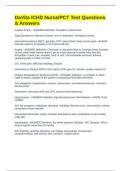DaVita ICHD Nurse/PCT Test Questions
& Answers
Cardiac Arrest: - ANSWER Definition: Cessation of heart beat.
Signs/Symptoms: Absence of pulse, lack of respiration, unresponsiveness
Interventions:Assess ABC's, get help, CPR, return blood, keep access open, call EMS,
maintain patency of needles or CVC ports with NS
Angina - ANSWER Definition: Chest pain or discomfort due to Coronary Heart Disease.
Occurs when heart muscle doesn't get as much blood as it needs. May also feel
discomfort in neck, jaw, shoulder, back or arm. Uncomfortable pressure, fullness,
squeezing pain in center of chest.
S/S: Chest pain, difficulty breathing, nausea
Interventions: Reduce BFR to 150, reduce UFR, give O2, monitor cardiac rhythm/VS
Dialysis Disequilibrium Syndrome (DDS) - ANSWER Definition: A condition in which
rapid or drastic changes in the patient's extracellular fluid affect the brain
S/S: Headache, hypertension, nausea, restlessness, convulsions/seizures, confusion,
blurred vision
Intervention: decrease BFR and DFR, shorter initial treatments,
Hypertension - ANSWER Definition: high blood pressure (Pre-Dialysis: >140/90; Post>
130/80)
S/S: No symptoms, headache, dizziness, Irritability, Blurred vision, nervousness, edema
secondary to fluid retention
Intervention:Determine cause, maintain fluid balance take medications as prescribed,
notify MD
hypotension - ANSWER Definition: low blood pressure (Systolic: <90, Diastolic: <60 or
drop in systolic more than 20 mm/hg
S/S: flushing, yawning, dizziness, ear ringing, tachycardia, anxiousness,
nausea/vomiting, cold clammy skin, seizures, cardiac arrest
, Interventions: place pt in supine position, decrease UFR to minimum, provide drinking
water for less severe hypotension, give 100-200 mL saline for severe hypotension,
monitor BP, notify RN
Muscle Cramps - ANSWER Definition: painful muscle contractions in extremities or
abdomen typically occurring due to rapid/excessive fluid removal.
S/S: painful cramps usually occuring later in dialysis
Intervention: massage or apply opposing force, give normal saline bolus, reduce UFR,
assess dry weight
Fever & Chills - ANSWER Definition: Any temp greater than 100° F or increase over
baseline of 2° F with symptoms
S/S: Temp >100°F, involuntary shaking, chills, hypotension, nausea, vomiting,
headache, hypotension, tachycardia, hot flushed skin, dry mucous membranes
Interventions: nurse must assess pt for possible cause of fever, notify treating
nephrologist and obtain cultures per protocol, administer antibiotics as ordered
Pyrogen Reaction - ANSWER Definitions: elevated temp- usually occurs 45-75 min into
treatment as a result of pyrogens (endotoxins)
S/S: chills, shaking, fever, hypotension, vomiting, muscle pain
Intervention: Provide support, report pt s/s to RN, stop tx, do not return blood, notify MD.
Seizures - ANSWER Definition: involuntary muscle spasms and loss of consciousness
S/S: change in level of consciousness, twitching/jerking movements of the extremities
Intervention: protect pt and access arm from harm, protect airway, administer O2, d/c
dialysis
Blood Loss - ANSWER Definition: loss of blood typically due to dislodged needle,
bleeding at access site, disconnection of lines, system clotted and unable to return
blood.
S/S: hypotension, loss of consciousness, blood on floor, chair or clothing, blood lead
detector alarm, VP alarm if needle dislodged or line separate, TMP alarm, visible clots
in chamber
Interventions: Manage symptoms, give saline replacement if needed, give O2, fix cause
Clotted Dialyzer - ANSWER Definition: Dialyzer membrane clotted




